Note
why is the headstock to thoms Yairi Dy88 different than every other Yairi Dy88 I see pictures of?
For those who don't know, the K.Yairi DY-88 is an electro-acoustic guitar that Thom used on tour during the OK Computer era. He had two of them, but donated one to a homeless-support charity auction in 2004. The lack of sound-hole on the guitar means it won't feedback at high volumes, which makes it useful as a touring instrument. He seems to have first purchased one in around 1996, after the band's touring gear was stolen in October of 1995. Thom was perhaps most notably seen with the K.Yairi during Paranoid Android and No Surprises on Later... with Jools Holland in 1997. He also played one heavily during the 1997 Glastonbury festival, including for Karma Police.
However, it's worth noting that Thom likely used other acoustics in studio for OK Computer — particularly for Climbing Up The Walls, since that song features Thom singing into the soundhole of an acoustic (Nigel recently confirmed that Thom did so on the recording, not just at live shows).
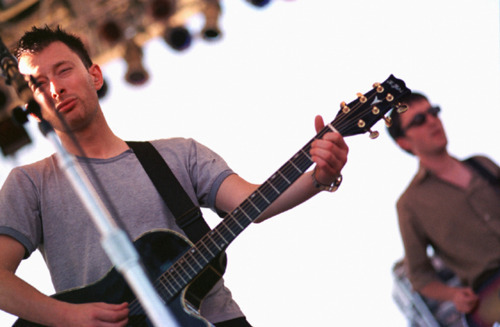
A photo of Thom and Colin performing in the late-1990s.
Headstock Inlays: K.Yairi vs Alvarez
In the late-90s photo seen above, the headstock shape looks pretty standard, comparing it to others on Reverb. The main difference is the headstock inlays. DY-88 instrument sold under the Alvarez brand simply have that company's logo inlaid on the headstock (as seen in those Reverb listings). Instruments sold under the Yairi brand have "K.YAIRI" inlaid at the top, and Yairi's triangle logo inlaid underneath. In addition, Yairi switched to a larger version of their inlay at some point in the 1990s. In the photo above, Thom's guitar has the latter inlays.
For most models, it's just a marketing difference. Alvarez is a USA-based brand/distributor, so guitars made for US market have that logo. According to some, instruments sold in the USA were marked as "Alvarez", while those sold in the UK and other regions were branded "K.YAIRI". If you dig around, you can also find instruments made for the Japanese market with the K.YAIRI inlays, including this eBay listing for a model called the YD-88S. But you can also found Alvarez-branded guitars sold in Japan, such as this YD-88 CTM with super simple fretboard inlays.
You can also find versions of the 88 with a rounder headstock shape sold by both brands. The official YD-88BK webpage shows an instrument with the K.YAIRI markings and the rounded shape. The "BK" in the model number stands for "black", and you can find maple ("M") and sunburst ("SB") versions as well.
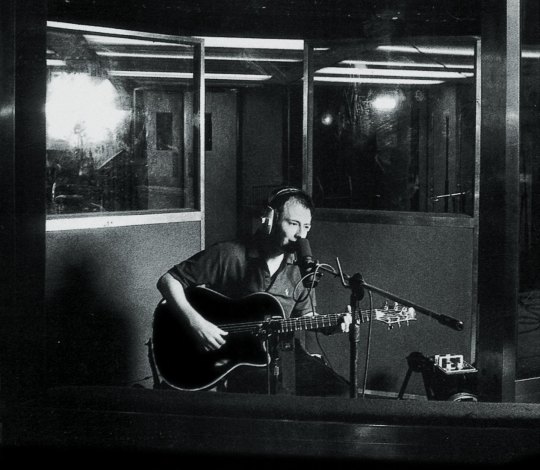
Thom with one of his Yairi guitars during Radiohead's session for the BBC in May, 1997 (photo by Tom Sheehan, edit by qwerrie). Note the "pointy" fingerboard inlays.
Fingerboard Inlays: Round vs Pointy
The fretboard inlays inlays add even more confusion. Thom's guitar has "pointy" triangular inlays along one edge of the fingerboard, with triangles at both edges at the twelfth fret. But at least two other inlay patterns were used on these guitars, seemingly at the same time. The other patterns are noticeable in some of the listings that we linked to above. Here's a used listing in the USA for a black DY-88 with the same "pointy" fingerboard inlays as Thom's guitar, but with Alverez branding. Here's a used listing in Japan for a YD-88 with the same fingerboard inlays but with the K.YAIRI headstock inlays (it also features an aftermarket Roland MIDI modification — that guitar must've had an interesting life!). So the fingerboard inlays aren't specific to any region.
Model Number: YD-88 vs DY-88
You may have noticed that some of these are listed as "YD" rather than "DY". Here's a used listing in Japan for a black, 1993 YD-88 that looks identical to Thom's instrument, with both the K.YAIRI branding and the "pointy" inlays. This is one of few listings that shows an actual photo of the official model number, and it's listed as YD-88BKN. Presumably these same instruments were exported to the UK as well. But it's believable that Thom could've bought the guitar in the UK or when touring in Japan. So it seems likely that Thom's guitar is in fact a K.YAIRI YD-88, rather than a DY-88.
However, I can't find any consistent difference in the specs between the YD and DY version. So it may also have been regional marketing, just like the brand inlays on the headstock.
Needless to say, this company created quite a few aesthetic variations over the course of the 90s, but ultimately they all seem to be the same instrument.

This clipping from a 1993 Japanese catalogue highlights the YD-88BKN on the far left.
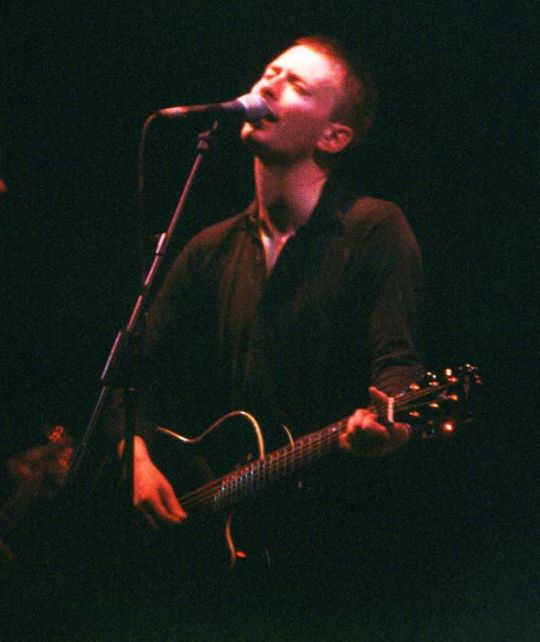
Thom playing a K.YAIRI guitar at the 1997 Glastonbury festival. Note that it has the smaller, angled version of the K.YAIRI logo.
7 notes
·
View notes
Text
New Pedal Manuals
This week, we updated the manuals for all four of our pedals. The manuals are written in a similar style to our site, and should have some helpful info on topics like signal placement even if you don't own any of our pedals. If you do own a pedal, the manual for the Mini Glitch should be particularly helpful, as it now explains the calibration process for V1.3 pedals in detail.
Links can be found found on the pages for each pedal (see the sidebar), or at the links below:
Mini Glitch: Manual PDF
Oxford Drive: Manual PDF
EQ-201 Preamp: Manual PDF
Pitch Magpie: Manual PDF
3 notes
·
View notes
Text
Thom's Nylon String Guitar

A shot of the guitar on one of the band's overhead screens show the three control knobs for the electronics near the neck on the side of the upper bout.
Fan footage from the Smile's show at 3arena in Dublin has provided some clarity on the classical guitar that we first mentioned in our analysis of the band's rehearsal setup. The guitar appears to be a Taylor 312ce-N, which is a single-cutaway electro-acoustic nylon-string guitar. Thom used the guitar for finger-strumming on the song Wall of Eyes. It's possible that Thom used the Taylor on the album recording. But it seems more likely that he purchased the electro-acoustic Taylor as a touring alternative to whichever acoustic instrument he used on the track.

A shot of Thom with the guitar during Wall of Eyes, from a fan video shared on the band's discord.
The footage has revealed one other interesting detail about the live arrangement of Wall of Eyes: Jonny is playing an extremely unusual guitar. But more info on that later...
UPDATE
We now have a much nicer photo, shared by @miguel_ruiz:

11 notes
·
View notes
Text
The Smile's 2024 Tour Rehearsal Setup
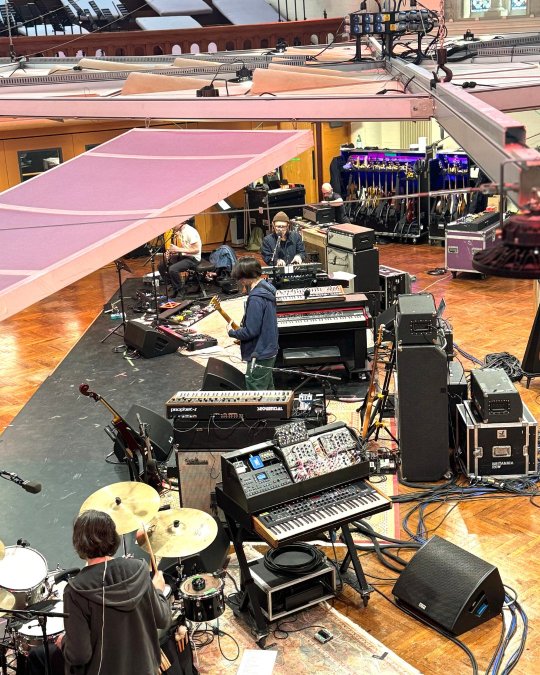

On March 5 and March 6, The Smile shared photos taken by Ade B during rehearsals for the band's 2024 tour dates. In the photos, the band are set up in Air Studios’ Lyndhurst Hall. It's a space where Jonny has frequently recorded orchestras, including for the Phantom Thread soundtrack. A photo from circa-2014 revealed that Radiohead’s string arrangements for Spectre (and possibly Man of War) were also recorded in the room.
The Smile’s live setup largely resembles the one they used for their tour dates last year. This isn’t a surprise, since many songs from the band’s latest album were written on the road. However, there is some new gear which seems to be intended for material off the new album. Further down in this post, we’ll list all of the gear, but we’ll highlight the changes first.
Electric Cello and Viola
Almost certainly the biggest surprise is that Jonny has added an electric cello and an electric viola to his setup. In the past, Jonny has occasionally played bowed string instruments on recordings, but they were always acoustic instruments, and he's never brought them on tour. Most of the time, Jonny only used his viola to sketch out string arrangements, which were then recorded by other players. And at live shows, Jonny has always bowed his electric guitar or bass to emulate those string arrangements, whether it's the harmonics on Pyramid Song or the col lengo crunch on Burn The Witch.
However, Jonny has started to play the cello more regularly in the past few years. In an interview from the 2010s, Jonny mentioned that he could make noises that he’s happy with on a cello, but claimed his left hand isn’t precise enough to perform with it. Then in 2019, he mentioned that, compared to viola, the cello "feels much more natural to hold and so much easier to make a nice sound on — I only wish I had moved on to it when I was a kid” (The Times). In 2021, he was credited with cello in the liner notes for the Power of the Dog soundtrack, applying banjo-style technique to the instrument. And this year, he was credited with cello in the liner notes for Wall of Eyes. In fact, Jonny can be seen playing his acoustic cello in a couple of polaroids posted in March 2023, during the recording of the new album.
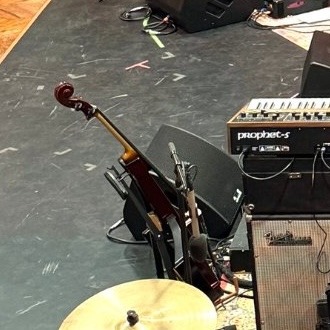
A closeup of the electric cello (left) and viola (right).
Digital “Upright” Piano
On every tour since 1997, Radiohead have brought an acoustic upright piano on tour. Usually they brought a Yamaha U1, though more recently they’ve favored a Kemble KC121 (essentially a U1 built at Kemble’s factory in the UK, rather than by Yamaha in Japan). The same was true for Atoms for Peace shows in 2010 and 2013. The Smile followed this trend, bringing an acoustic upright along for all of their tour dates from 2021-2023.
However, given how few of the Smile's songs require piano, it’s understandable that they’d switch to a digital instrument instead. The one they chose is a Nord Grand digital piano, which features fairly authentic piano hammer-action made by the piano maker Kawai.
For some solo shows in support of Anima, Thom brought a Waldorf Zarenbourg for sampled acoustic and electric piano sounds. Thom only played it for a couple songs each night, so it was understandable that he didn’t want to tour with an acoustic upright. However, it’s interesting that The Smile are still using their vintage Rhodes electric piano, rather than using the Nord Grand for Rhodes sounds in addition to acoustic piano sounds. Perhaps keyboard action is the reason: the hammer action of the Nord might be accurate for piano, but it’s probably a little heavy for Rhodes playing. Plus it’s clear that the band enjoy having a lot of keyboard on stage to experiment with.

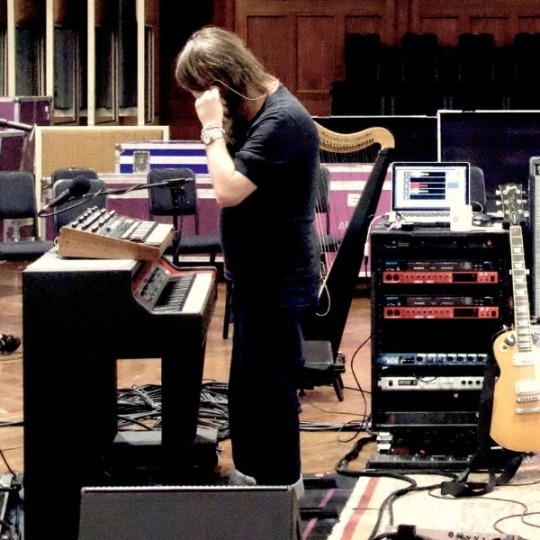
Closeups showing the Nord Grand in its custom black stand.
Sequential Prophet 6
One benefit of the digital piano is that its shorter stand leaves space for a keyboard to rest on top. For this tour, Thom has brought along his Prophet 6, which he previously used for the Suspiria soundtrack and for shows in support of Anima. This isn’t the first time that the band have mixed piano and synth. Thom did velcro a Dave Smith Instruments Tetra to Radiohead’s upright piano from 2012-2013. However, that synth saw little use, perhaps because of the Tetra’s minimal control layout.
The band now have three Prophet synths in their active setup: the Dave Smith Prophet ’08 beneath the modular, the Sequential Prophet 5 REV4 on top of the Rhodes piano, and the Sequential Prophet 6 on top of the digital piano.
Earthquaker Devices Blumes
In addition to the Earthquaker Devices Plumes overdrive on Thom’s board (note the green), it looks like he’s added a Blumes overdrive as well (the similarly-sized yellow box). The Blumes is intended as a bass-friendly version of the Plumes. Thom was already using the Plumes with his bass guitar for a very punchy sound, so it’ll be interesting to see how he uses the bassier Blumes.
The green of the Plumes and yellow of the Blumes can also be seen on Thom’s backup pedalboard, which is resting on top of one of the gear cases by Thom’s guitar stands.
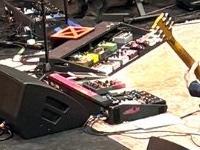
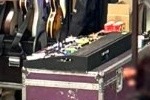
Closeups of Thom's guitar and vocal pedalboards (left) along with his backup guitar pedalboard (right).
Eventide Pitchfactor
It looks like Thom has added an Eventide Pitchfactor to his vocal pedalboard. It's in the spot where he had an Eventide H9 on the last tour, so it's likely that he was using the H9 for pitch shifting sounds. The H9 features all of the algorithms from the Pitchfactor (as well as the other Eventide pedals), but it has far fewer knobs so controlling it is more cumbersome.
Jonny's Setup
Jonny's Chordophones
Gibson Les Paul Standard Natural Finish (late-1970s)
Fender Precision Bass Natural Finish (early-1970s)
Electric Cello
Electric Viola
Dusty Strings Ravenna 34 harp
Jonny's Gibson Les Paul Custom and ES-125 are probably on a stand out of view.
Jonny's Guitar Pedalboard
Currently unknown, but likely similar to his summer 2023 pedalboard.
Jonny's Guitar Amplifier
Fender '65 Reissue Super Reverb No1
Fender '65 Reissue Super Reverb No2
Jonny's Bass Pedalboard
Boss TU2/3
Boss DD200 (replaces Akai Headrush E2)
Two Notes Le Bass preamp
Jonny's Bass Amplifier
Ampeg SVT Classic amplifier head (1990s)
Ampeg SVT Classic amplifier head (backup)
Ampeg 8x10" Cabinet
Jonny's Laptop Setup
Apple Macbook Pro
Furman M-8Lx
MOTU MOTU Midi Express XT No1
Focusrite Clarett+ 8pre No1
MOTU MOTU Midi Express XT No2
Focusrite Clarett+ 8pre No2
Radial Engineering SW8 8-channel auto-switcher
Hinton Instruments Z4 Quad Channel Long Haul Converter
Blackstar Live Logic 6-Button Foot Controller No1 (kept by laptop)
Blackstar Live Logic 6-Button Foot Controller No2 (velcro'd to Studiologic pedal)
Jonny's Synthesizers Setup
Sequential Prophet-5 REV4
Peterson Strobostomp HD tuner (for Prophet 5)
Earthquaker Devices Avalanche Run delay/reverb (for Prophet 5)
Studiologic MP-117 MIDI Pedalboard (controls Prophet 5)
It appears that Jonny has stopped touring with his Oberheim SEM Pro synthesizers, which he'd used for bass sounds on previous tours. So he's likely either using samples or his Prophet 5 for all of his bass synth needs.
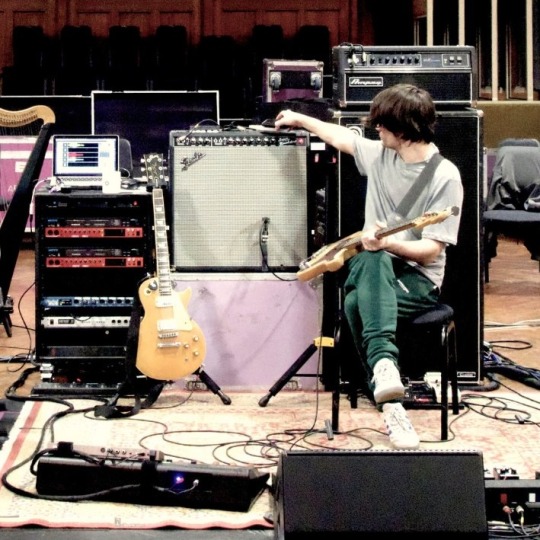
A closeup of Jonny's setup.
Thom's Setup
Thom's Chordophones
Martin 00-18?
Fender Jazzmaster Black Finish (1963)
Fender Jazzmaster White Finish (1964
Epiphone Casino Royal Tan (mid-1960s)
Epiphone Casino Sunburst (circa-1962)
Gibson SG (1964) No1
Gibson SG (1964) No2
Martin 00-18?
Fender Jazz bass
Gibson EB-0 bass
unknown classical guitar
unknown (semi-)hollow bass
Fender Mustang bass
unknown (semi-)hollow electric guitar
Thom's Guitar, Bass, and Vocal Pedalboards
Thom's current pedalboards seem mostly similar to the ones he used last year (see Thom's pedalboards page), aside from the changes mentioned above and the removal of the Soma Cosmos from the guitar board.
Thom's Guitar Amplifier
Vox JMI Vox AC30/6 (1962)
Thom's Bass Amplifier
Fender Super Bassman head
Fender Super Bassman head (backup)
Fender Bassman 610 Neo cabinet
Thom's Synthesizers
Waldorf STVC
Moog Matriarch
Sequential Prophet 6
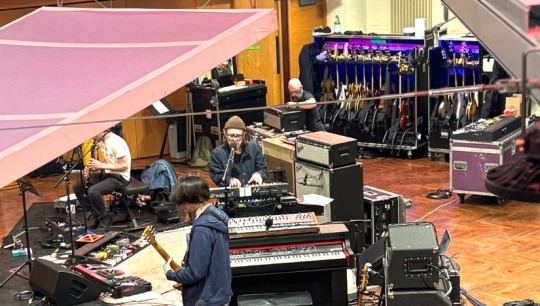
A closeup of Thom's setup.
Tom Skinner's Synthesizer Setup
Tom Skinner's Prophet Setup
Dave Smith Instruments Prophet '08
Roland FS-5U (sustain pedal for Prophet '08)
Tom Skinner's Modular Setup
Boss TU-3S tuner
JBL GO3 Portable Waterproof speaker
Unknown 4-knob Mixer
Elektron Octatrack MK2 (sequences the modular)
Make Noise Strega
Make Noise 0-Coast No1
Make Noise 0-Coast No2
Mutable Instruments Yarns MIDI-to-CV
Make Noise Richter Wogglebug random generator
Make Noise Echophon delay
Vermona twinOUT dual balanced output No1
Vermona twinOUT dual balanced output No2
Some other modules aren't possible to identify from this photo, but they probably match the ones seen in previous photos.
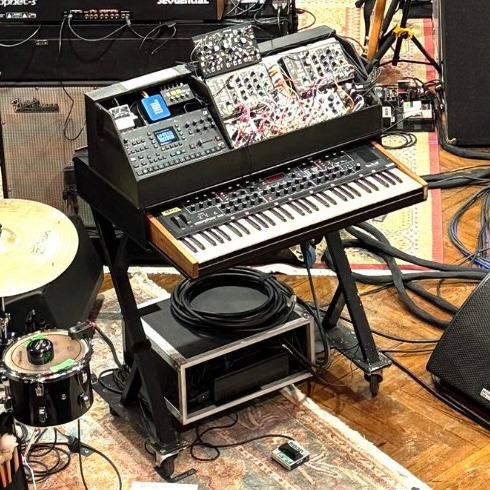
A closeup of Tom Skinner's synth setup.
Shared Keyboards
Nord Grand (in custom black stand)
Fender Rhodes piano
26 notes
·
View notes
Text
Jonny recording in the Control Room at Abbey Road Studio 2

Earlier today, The Smile shared this photo of Jonny by Sam Petts-Davies on their official social media. Jonny is seen with his late-70s natural finish Gibson Les Paul Standard, a guitar he's used extensively for work outside of Radiohead.
The photo is quite similar to two others taken by Sam in the same room, as we've discussed previously. However, this one differs because it shows a few pedals. From right-to-left, we see the following:
Death by Audio Interstellar Overdriver
Boss DD-200 delay
Electro-Harmonix Stereo Electric Mistress XO flanger
The Interstellar Overdrive is a favorite of Thom's, and he even had two on his board at one point (one for guitar and another for bass). But this is the first time we've seen Jonny using one.
It's also the first time we've seen Jonny using an EHX Stereo Electric Mistress. Aside from a brief dalliance with a big-box EHX Polychorus (which he used more as a chorus) in the mid-2000s, Jonny has generally avoided flanger pedals through his career. Perhaps he's wanted to avoid sounding too much like John McGeoch (Magazine, Siouxsie and the Banshees), perhaps the guitarist who most influenced Jonny during his youth. According to Johnny Marr, "[McGeoch's] intention was to be modern and you hear that in the very deliberate choice of using the flanger on everything” (The Guardian).
But more recently, Jonny has been using an EarthQuaker Devices Pyramids flanger on performances of Read The Room. That's almost certainly the reason the song was briefly called It/Flangers. So it's very possible that this photo was taken during overdubs for Read The Room, with Jonny experimenting with new flanger pedals. The two pedals that are plugged in (Interstellar Overdriver and DD-200) certainly seem right for the track. There are several guitar overdubs, as we mentioned in our full analysis of the track, so it's easily to imagine the pedals being used for at least some of them.
Given that the Electric Mistress isn't plugged in, one can only guess whether it was used on the final recording. Perhaps Jonny opted to let Sam add studio (maybe tape) flanging to the finished recording. It's slower than tracking with the flanger added, but it's also safer since it allows Sam to lessen or remove the effect during mixing.
15 notes
·
View notes
Text


A couple shots from The Smile's rehearsal at RAK Studio 1 in January 2022, in preparation for their three live-streamed Magazine shows. Thom's phone, resting on the music stand, has an Intellijel sticker on its case. The photo below, from Intellijel's facebook, shows a closeup of the sticker design. According to Intellijel, these stickers were new in 2019, so Thom must've bought some new Intellijel modules in 2019-2021.
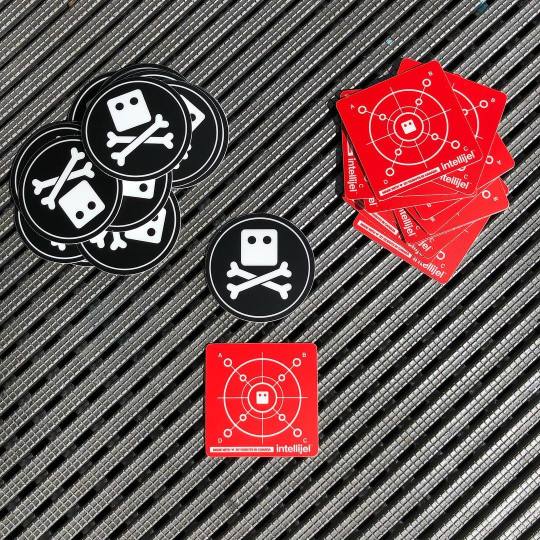
8 notes
·
View notes
Text
‘Read The Room’ Instrumental Notes

Jonny dramatically muting the strings of his late-70s natural finish Les Paul Standard during a performance of Read The Room in Cleveland on July 11, 2023 (Ryan J).
Verse
Read The Room starts with just a guitar through a single-repeat delay. Well, technically two guitars: the same guitar part is recorded twice, with one recording panned hard left and the other panned hard right. Each one has its own delay. Jonny almost certainly used his Boss DD200, given the clarity of the delay sound (a Space Echo would be too warm in the highs). If we count quarters at ~61.5bpm, we can hear that the delay time is set for a single quarter note.
There’s also medium overdrive and a flanging effect added to Jonny's guitar. The overdrive is probably Jonny's Boss SD1, which he's found a new affection for with The Smile (since 2007, he's used a Boss OD3 with Radiohead instead of his older SD1). The flanger is almost certainly from the EarthQuaker Devices Pyramids visible on Jonny’s board in studio photos.
At 0:09, Thom’s bass guitar enters. Based on live usage, he's probably playing his vintage, modified Gibson EB0. You can also see that bass in a photo from the the Wall of Eyes zine, which we included in our last post.
At 0:13, the drums enter, with Tom playing a stuttering pattern on the kick and snare, with occasional cymbals and open hihats for emphasis.
At 1:07, Jonny’s Sequential Prophet 5 REV4 adds a nice descending counter-melody (at least, it's probably the Prophet based on studio photos and similarity to the live tone). When the synth enters, Jonny switches to plucking muted strings on his guitar for a totally percussive sound, which leaves space for the synth to stand out. At live shows, he mutes the strings rather dramatically, sliding his hand up and down the fingerboard to vary the sound of the percussive plucks.
At 1:37-1:41 some slightly open hihats lead us to the next section...

A photo from Jonny's home studio in Oxford, showing his Sequential Prophet 5 REV4 nestled between a 1980s Sequential Prophet 600 and an Elektron Digitone Keys. This photo by Sam Petts-Davies was originally posted on the Smile's twitter on October 31, 2023, but was definitely taken much earlier since the band were on tour at that time.
Chorus
At 1:41, the song switches to a softer “chorus” section, and a center-panned acoustic guitar becomes the main rhythm instrument. However, Jonny’s left and right panned electric guitars keep playing, adding subtle swelled notes. He’s probably using the “freeze swell” trick he first used for the Skirting On The Surface outro solo — more info in this post. However, it’s hard to say for sure, given the amount of woodwinds in this section. Robert Stillman's clarinets and Pete Wareham's flutes enter more clearly at 1:53. They add a rich, undulating texture through to the end of the chorus at 2:08.
For most of the chorus, we only hear a gentle hihat pattern from Tom. But at 2:00, we first hear cymbals, then the kick and stuttering snare from the verse enter to lead us back out of the chorus.
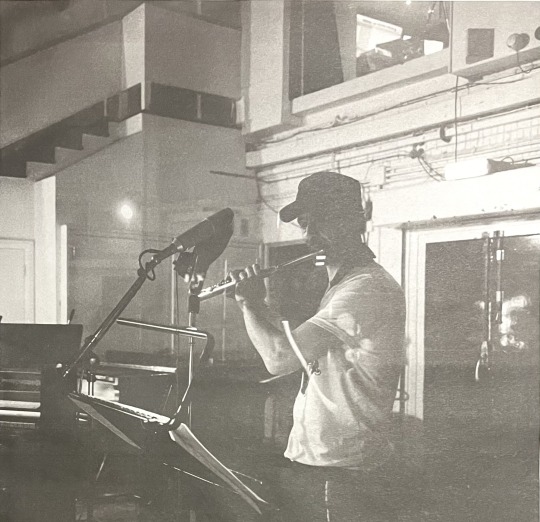
A photo of Pete Wareham playing flute in Abbey Road Studio 2, from the Smile's Wall of Eyes zine. Wareham previously collaborated with Tom Skinner’s past band Sons Of Kemet.
Verse 2 and Chorus 2
At 2:08-2:11, the start of the next verse, we briefly hear the main riff on the single acoustic guitar from the chorus. Then Jonny's two hard-panned electric guitars return at ~2:11. This verse (2:11-2:40) mainly repeats the instrumentation from first verse, but with more cymbals and more intense vocal delay. However, we do get a left-panned clarinet playing the counter-melody at 2:25-2:36, replacing the synth from the first verse. We also hear some fun sliding noises — seemingly from a “delay time” knob being turned — at 2:26-2:30.
The second “chorus” (2:41-3:11) brings back the acoustic guitar, swelling electric guitars, woodwinds, and gentle hihats from the first chorus. The main difference is that the winds play a richer texture, and Jonny’s two electric guitars start to add spacier delayed notes at ~3:00 (possibly with his Boss RE-202 Space Echo pedal).
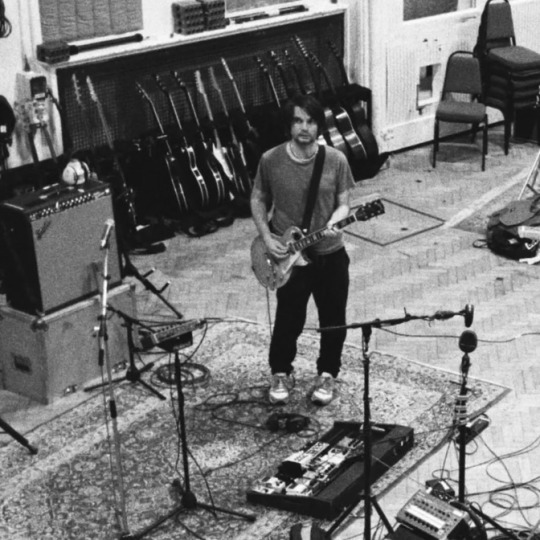
A photo of Jonny in the live room at Abbey Road Studio 2 from March or April of 2023 (Sam Petts-Davies). We can see his EHX Freeze, Boss SD1, Boss DD-200, and Boss RE-202 in the bottom row. His EQD Pyramids is at the end of the top row. For more info on his pedalboards, check out Jonny's page.
Coda
The coda begins at 3:12 with a right-panned single electric guitar from Jonny and a cymbal crash from Tom. Jonny plays a riff that initially feels pretty simple, until you notice that he keeps skipping eighth notes. There's a few ways to divide it up, but the full pattern is 22 eighth-notes long (two measures of 11/8, though it's easier to count as two measure of 6/4 with the last eighth note or each measure skipped, which also feels closer to the way the band play it).
Unlike the previous sections, this guitar has no delay or other effects. Instead of delay, Jonny’s riff makes use of open strings to give a fuller, multi-voice sound. On the studio recording, his B-string is detuned to an A for this section, allowing him to add an open “A” ringing over his riff. This is pretty notable, because the song’s main riff used an open B-string in standard tuning! At live shows, Jonny doesn’t bother with the high “A”, presumably because he has no time to detune the B-string or to switch guitars. So that's a little extra studio magic!
Jonny most likely played his late-70s natural finish Les Paul Standard for most or all of the studio recording. He's seen with other guitars in a few studio photos, but his tone on this track has a richness that's characteristic of his Les Paul through his Super Reverb — particularly his clean tone in the code.
The cymbal crash from the start of the coda slowly fades from 3:12-3:19. Then at 3:20, a couple of snare hits call in a new pattern of kick, snare, and closed hihat. The pattern is reminiscent of the "motorik" beat found in a lot of Krautrock, with a snare on 3. But the skipped eighths in the riff make the beat much more varied than in a traditional Krautrock track.
Thom adds a distorted bass guitar at 3:23, mirroring Jonny’s riff an octave below. He’s probably using his EarthQuaker Devices Plumes pedal for the added punch. In live footage, we can also see Thom and Jonny grab plectrums at the start of the coda. Thom may have been using the Plumes earlier in Read The Room, but the plectrum really emphasizes the punch.
When Thom’s vocal re-enters at 3:45, there’s a ton of vocal layers and reverb. The layers all seem to match the main vocal, so it might a dual delay setting from Thom’s Strymon DIG pedal, albeit with some heavier reverb added to the delays. At live shows played after the Abbey Road recording sessions, Thom had a drone from his Moog Matriach playing during this section, but it’s not present on the album.
At 4:05, Jonny adds a second electric guitar layer, panned hard-left and playing patterns with a new single-repeat delay. At live shows, he relied on Thom to keep the riff going. But on the studio recording, his right-panned riff guitar keeps playing too.
Tom brings back the cymbals in earnest from 4:13-4:48, bringing the song to its climax. Then, after a choirs of Thom say "everybody thinks so" at 4:48, the cymbals and vocals drop out (with a long vocal delay fade-out). The guitar, bass, and drums continue up until the track ends abruptly with another statement of "everybody thinks so".

In this shot, from the The Smile's show in Cleveland on July 11, 2023 (Ryan J), Jonny's tech can be seen tapping in a dotted-eighth delay during the start of the coda section. Jonny only uses the delay during the second half of the coda, but his delay time is different from the rest of the song, so it needs to be adjusted while he plays the initial coda riff. Thom can be seen with his vintage Gibson EB0.
#The Smile#Read the Room#Wall of Eyes#Tom Skinner#Thom Yorke#Jonny Greenwood#Skirting On The Surface#Staircase#Thin Thing#Present Tense
12 notes
·
View notes
Text
'Wall of Eyes' Film and Zine Gear Updates

On January 18, The Smile and Paul Thomas Anderson’s Wall of Eyes film collection was premiered at the Prince Charles Cinema in Leicester Square, London. The first piece in the collection is a silent film showing the band recording Wall of Eyes at Abbey Road. We initially see the band playing and talking in the live room at Studio 2, but as it progresses we also see them giving direction (and reacting amusingly) to the London Contemporary Orchestra (a slight surprise as Jonny usually record strings at Air Studio’s Lyndhurst hall).
As you might expect, most of the instruments and gear used by the band is similar to what they brought on the road. In an interview with Lauren Laverne for the BBC, Thom mentioned that the songs were mostly written very quickly, some on tour and some in studio. “Especially with Tom [Skinner], he’s super quick… so we could have an idea, and suddenly it's off the ground within like half an hour, and we started getting into this habit of like — take three was like ‘that’s it, move on.’” So it makes sense that the band would use much of the same equipment as on tour, if only to speed up the recording process.
However, there were a couple of surprises in the silent film. One shot showed Jonny with an Eventide H9 pedal floating beside his pedalboard. Previously, only Thom had used the H9, and Thom used it as a vocal effect. Another shot showed Thom playing his black 1963 Fender Jazzmaster. Thom’s old big-box Electro-Harmonix Holy Grail could also be seen beside his pedalboard, though it wasn’t plugged in.
The Wall of Eyes Zine
In addition to watching the film by PTA, attendees could also purchase a “zine” full of photos taken by Sam Petts-Davies during the recording of the new album. The zine is printed on newsprint, reminiscent of Radiohead’s Universal Sigh and The King of Limbs newspapers. The zine mostly shows the same gear seen in Sam's previous photos of the session, and some of the photos were previously shared on social media. But there are still plenty of new details to take in!

Jonny with Thom/Nigel's worn sunburst Fender Telecaster Standard. You might mistake it for Jonny's Tele Plus given the wear on the "horn" of the guitar, but the pickups and the white binding show that it's the Tele Standard that Thom first played for AMOK touring in 2013 (it was still very worn back then).
In one photo, we can see Thom playing a Martin acoustic, perhaps from the recording of the single Wall of Eyes. Another photo shows a be-speckled Jonny on a couch with Thom/Nigel's worn sunburst Fender Telecaster Standard. But before you assume Jonny has abandoned his Les Paul, he can be seen playing his (plugged in) natural finish Les Paul Standard in the studio's control room in another photo. Jonny is also seen with the Les Paul in photos from the live room at his home studio (the grey-blue painted room from which the Smile have previously shared rehearsal footage and photos).

This photo by Sam shows Jonny with his natural finish Les Paul Standard in the control room at Abbey Road Studio 2. It's very similar, but not identical, to the photo included in the zine. This photo was posted on the band's twitter on Oct 9, 2023, but it was most likely taken in March 2023, and only posted in October to help publicize the band's fall 2023 tour. If you want to look around the control room, a 360º view is available on 360cities.net, but it appears the room has been renovated slightly since that was taken.
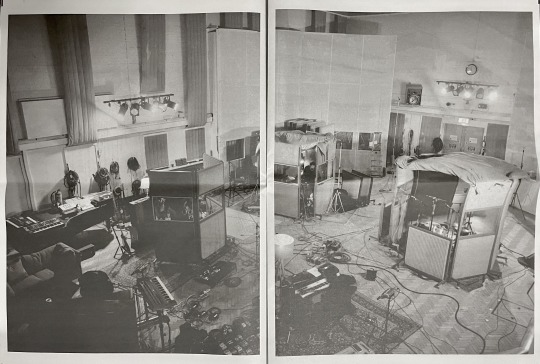
A wide view of the live room at Abbey Road Studio 2, taken partway up the stairway to the control room. Some particularly notable bits of gear include the Prophet 5 REV4 between Thom and Jonny's stations (presumably for shared access) and the Elektron Analog Rytm (partly blocked by Thom's head) on top of the Rhodes electric piano.
One of the largest photos in the zine, spanning two pages, shows a nearly full view of the live room of Studio 2. On the left, we can see an impressive array of synths resting on top of the grand piano, including Thom's Moog Matriarch and one of Jonny's Oberheim SEM Pro synths. Clearly the band prefer the sound of upright pianos for this project. While the grand is used as a synth table, there are two mic'd uprights just behind Thom's area. Jonny Sequential Prophet 5 REV4 is also visible on a stand between Thom and Jonny's stations, suggesting it's getting a lot of shared use. On tour, Jonny used his Studiologic MIDI pedals to play synth lines on the Prophet, and the synth can be heard layered with strings on the new studio recordings. The MIDI pedals aren't visible in studio photos, so presumably Jonny decided to play those parts by hand for the studio recordings.
Thom is seem sitting at the Rhodes piano, playing a guitar or bass. On too of the Rhodes he has a sheet of (presumably) lyrics, and also his Elektron Octatrack (which Thom previously used on the album recordings for ANIMA) Elektron Analog Rytm drum machine (which he used heavily on Tomorrow's Modern Boxes and (at least on tour for) Anima). Behind him, his phone is visible resting on top of his favorite amp for the past seventeen-ish years: a fawn JMI Vox AC30/6 from 1962 (the pre-Top Boost version).
Tom Skinner is seen playing in one of the two isolation booths for drums. Another isolation booth is set up in Jonny's section, but instead of Jonny it's Robert Stillman recording in it (at least, one can only assume Stillman based on the saxophone horn visible through the booth's window). Jonny himself appears to be sitting hunched over near the couch and coffee table — it's unclear if he's playing an instrument, or perhaps manipulating a Max patch on his laptop.
Stillman is visible recording saxophone and clarinet in other photos from Studio 2 as well. He's credited for clarinet on Read the Room, and for clarinet and saxophone on Friend of a Friend, Pete Wareham, who previously played with Skinner's past band Sons Of Kemet, is seen recording flute in another photo from Studio 2. Wareham is credited for flute on Teleharmonic and Read The Room.

This photo of Tom Skinner in Studio 2, previously posted on the Smile's twitter page, was also included in the zine. It appears to have been taken during setup: the isolation booth isn't fully set up yet, and a ladder can be seen on the right.

Another photo (above) shows Thom's guitar and bass pedalboard. The first row of pedals (closest to him) are all favorites from the past few Smile tours (check his pedalboards page for more info). On the second row, EarthQuaker Devices Sunn O))) Life pedal has been squeezed between his EQD Afterneath and his Telenordia Kompressor. There's also an array of (unconnected) overdrive and fuzz pedals resting on the riser at the top of his board (we saw many of the same pedals arrayed there in a previous photo from the session).
In that photo, we also see Thom playing his modified 1960s Gibson EB0 bass guitar through an Ampeg B-15 Portaflex combo amplifier. The EB0's original single coil pickup is replaced by a Kent Armstrong Tele Dual Rail pickup (thanks to Makoto for pointing this out) on a custom plate, presumably a mod by a previous owner. Jonny is a big fan of the Ampeg Portaflex, having used a 2000s Portaflex B15R for sessions with Radiohead and Shye Ben Tzur, and also for the Smile’s debut live stream from the 2021 Glastonbury festival. The original 1960s Ampeg Portaflex was favored as a recording amp by American bassists like James Jamerson and Donald “Duck” Dunn — both notable influences on Jonny’s brother Colin.
It's interesting to note that none of Jonny's ondes Martenot are visible in the photos from Abbey Road. On tour, it's understandable that Jonny doesn't play the monophonic Ondes, because he almost always needs to play many notes at a time to fill out the rhythm section on the Smile's songs. But the the bridge/coda of the Wall of Eyes single prominently features Ondes Martenot (though it's often layered with strings). Perhaps Jonny overdubbed those parts at his home studio, or at another studio during mixing.

This photo of Thom in the control room of an unknown studio was posted on the band's twitter account on August 30, 2023 (photo by @sampettsdavies). It's definitely not from the control room in Abbey Road Studio 2. Perhaps it's the mysterious "StudioFour" in London, which is listed as the mixing location in the album's liner notes.
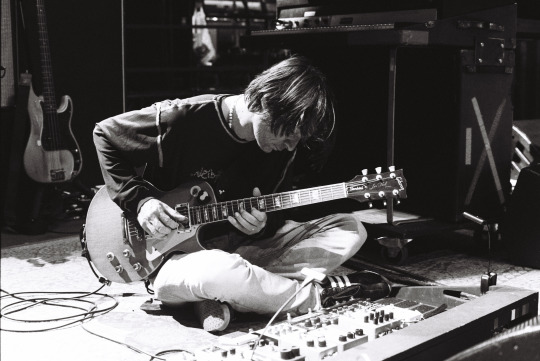
This photo of Jonny on stage during a soundcheck with The Smile is also included in the zine. It was posted on the band's twitter account on Sep 5, 2023 (photo by @sampettsdavies). It, like the photo set posted 4 days earlier, is probably from the band's July 2023 tour.
#The Smile#Wall of Eyes#Jonny Greenwood#Thom Yorke#Tom Skinner#Robert Stillman#Friend of a Friend#Read the Room#Teleharmonic
17 notes
·
View notes
Note
Hi! Do you believe Jonny and Ed use the Digitech Whammy after or before the distortion pedals in their chain? Everything I have seen seems to indicate that Ed uses the whammy pedal after the distortion. I guess it should be a different, more saturated sound that suits his role in the band more? Jonny Greenwood seems to be placing it before his Marshall Shredmaster but after his BOSS SD1, though I have not found 100% evidence for this on the internet. What do you think?
You can find each of their signal chains explained in great detail on the pedalboard sub-pages for each artist (also found in the right sidebar):
Thom Yorke's Pedalboards
Jonny Greenwood's Pedalboards
Ed O'Brien's Pedalboards
You can also find an in-depth look at Jonny's 1997 signal chain in this article (his basic chain has remained identical since 1996, with just the occasional pedal addition or swap).
For Ed's signal chain, our article on creating an Ed O’Brien Starter Pedalboard is a good place to start.
But short answer:
Jonny's Whammy is before both his SD1 and his Shredmaster, each of which has a separate path to its own amplifier. This is partly just convenience: in order to use the Whammy with both amplifiers, he needs to put it before the LS-2 that selects between them. Jonny isn't using a Whammy with The Smile, but his latest board with that band has an EHX Pitchfork placed before his SD1.
Ed's Whammy is placed after his distortions, but not for the reason you might think. He has the Whammy between some of his loopers and delays. It varies from tour to tour, but in his reduced "7 Worlds Collide" board the Whammy was between Ed's DD5 and his Line 6 DL4. This allowed Ed to pitch shift not just his dry signal but also the delays from the DD5, which probably gave a more cohesive sound given Ed's "synthy" approach to pedal chains.
3 notes
·
View notes
Text
Jonny's Fender Acoustic

This photo of Jonny playing a Fender dreadnought acoustic was taken by his son Tamir.
To help publicize their upcoming Steve Reich Festival, The Hallé recently shared this photo of Jonny playing a Fender dreadnought acoustic guitar. Jonny will be playing Reich's Electric Counterpoint on the third (and final) day of the festival.
Back in November 2012, Jonny answered fan and celebrity questions in an article for Uncut magazine. Nicolas Gauna from Buenos Aires asked Jonny about his first guitar and the first song he learned, and this was Jonny's reply:
I bought a Fender acoustic for £40 from a “for sale” column in the Oxford Journal when l was about 14, then an electric one from my teacher when l was 16. I still have the acoustic, but the electric one was stolen in Leeds on the first Radiohead tour (at the Duchess Of York, I think… it was a cream Telecaster if anyone's seen it). I don't remember working out many songs by other bands - maybe “Psycho Killer" by Talking Heads. There was a tiny guitar room at school where teenagers hung out playing each other U2 songs - but I never had any U2 records.
Given Jonny's penchant for stickers during his younger days, one can only assume that this is the same guitar that he played when he first strummed his way through Psycho Killer.
Based on the quote, the guitar was purchased in around ~1985, and was already used by that point. Fender had released their California series acoustics in 1983, but they were still relatively new and expensive. So it's more likely that the guitar is from Fender's standard F-series. Price lists show that the F-series was available from Fender through the 70s and 80s. The headstock confirms this: California series guitars have a Stratocaster-style headstock, whereas Jonny's has a more traditional acoustic headstock with the distinctive F-series notch in the center. In addition, we can see a square "Fender" label through the soundhole. A cursory glance through Fender F acoustics shows that the square label was used in the 70s and early-80s, particularly on Japanese-made instruments. They seem to have switched to a round label in the late-80s. This gives further evidence that the guitar in the picture really is Jonny's original acoustic.
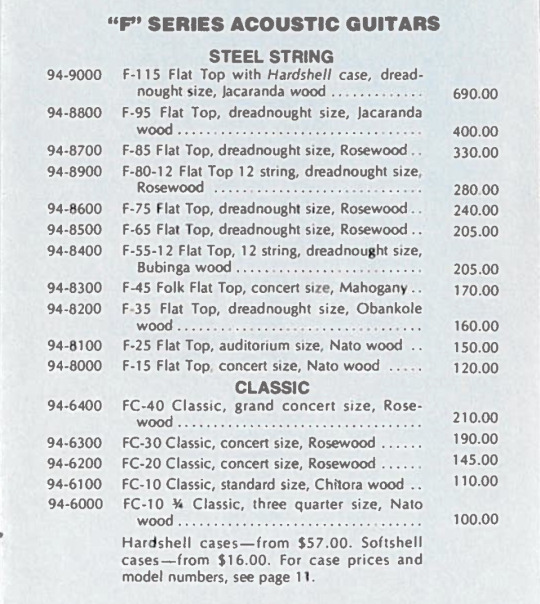
Fender's acoustic and classical guitar offerings in April, 1977 (guitar-compare.com). Given the price Jonny paid for a used instrument, it seems very possible that he bought a 1970s F-35 model. The more expensive models like the F-65 had fancier inlays and details, whereas the one in the photo has simple dot inlays on the fingerboard.
#Radiohead#The Smile#Jonny Greenwood#Steve Reich#Talking Heads#U2#Electric Counterpoint#Psycho Killer#Fender
20 notes
·
View notes
Note
Hey I just need to say absolutely adore your work here it has helped people such as me soo much on pretty much everything you need to know about their gear and I wanted to ask if I can’t spend that much money on an Marshall shredmaster what pedal can you recommend that is cheap that delivers that Marshall in a box sound as I bought an fender 85 today and I’m just stuck on what pedal to pick that is student budget friendly and can you possibly help with what amp settings jonny used in glastonbury 2003? Help would be much appreciated!
Just get a used ProCo Rat (standard version) and focus in your playing. Jonny didn't use one, but there's a reason so many people think he did: with the filter knob set right, the Rat has a similarly focused tone to the Shredmaster in the mids and highs.
The Shredmaster and Rat both use opamp hard-clipping followed by diode soft-clipping, so it's not a surprise they're similar (however, the Shredmaster has two stages of opamp clipping). The Rat lacks the post-clipping bass boost of the Shredmaster, but you can compensate for that with amp settings. Obviously, the Rat is less versatile than the Shredmaster, since it can't create scooped tones. But it does a good job of Jonny's favorite Shredmaster setting: contour knob at minimum for full mids and no scoop.
A bonus of getting a cheap, used Rat is you can quite easily modify it with a "clipping" switch, which gives access to Turbo Rat tones (the Turbo was Thom's favorite drive in the 90s, and that's probably the reason people used to think Jonny used a regular Rat). You can also get a Turbo Rat and add a switch for regular Rat tones, but the Turbo is usually pricier. Or, if you're particularly interested in soldering, you can build a mini Rat clone for about the price of a used regular Rat.

A shot of Thom about to stomp on his ProCo Turbo Rat during 2+2=5 on the Jonathan Ross show on November 7, 2003 (youtube).
Another Radiohead-related option is a Boss OD3, one of Jonny's favorite overdrives since ~2006. The OD3 has a distinctive tone of its own, but with the tone set right it has a bit of Marshall flavor too. And, like the Shredmaster, it has a post-clipping bass boost for a fuller sound. I also think it's a nice starter pedal, since it's more dynamic and "amp-like" than the Shredmaster and Rat (that's due to the OD3's discrete-opamp soft-clipping circuitry). It's quite usable from low to mid to high gain, so it could easily be your only drive pedal.
For settings, check the Fender Eighty-Five entry on Jonny's amplifiers page. But remember: even replicating his settings exactly will still sound different from studio recordings, because you're missing the signal chain after the amp's speaker (mic, EQ, compression, gates, etc). So (as always) it's better to use your ears and tweak the settings to find those sounds. We discuss this in more detail in this post.
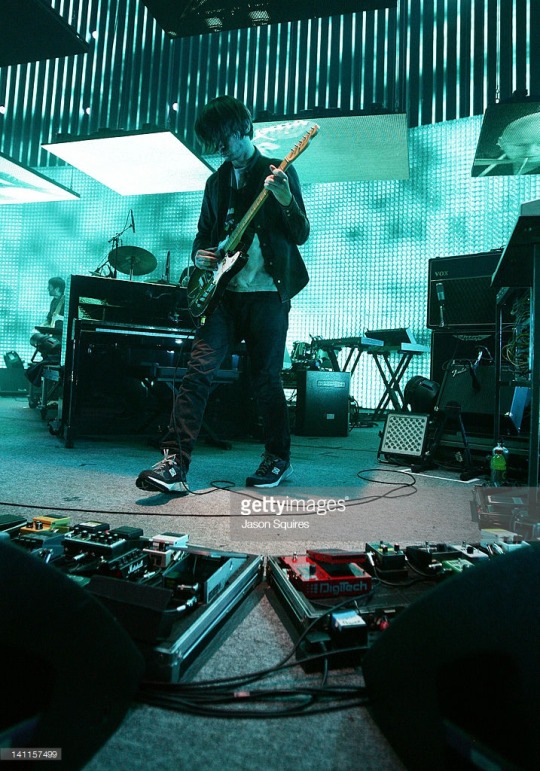
A photo of Jonny performing with Radiohead in Kansas City in 2012 (Jason Squires). You can see his Shredmaster and his OD3 on the board on the left.
8 notes
·
View notes
Text
We've made a new pedal!
youtube
Here's the first teaser for our new Pitch Magpie pedal, a pitch shifter that aims to capture the best of the weirdest pitch shifters from the 90s...
Background
For the past couple years, we've been trying to make a delay-based pitch shifter that sounds good. It hasn't been easy. There's a reason that most pitch shifters have switched to FFT-based algorithms: latency. There's a reason the monophonic Whammy is more popular than the delay-based PS3. Usually, to make a delay-based shifter sound decent, you need to use long delay times, which creates some serious latency. That's fine for organ type effects, but it can be pretty limiting. In contrast, reduce that latency too much and you've got a metallic ring mod, especially on the lowest string of the guitar. But with some tweaking and some crossfade tricks, we think we've found the perfect middle ground. And although there's still a tiny bit of lag, you probably won't care once you add the filters or vibrato haha!
Why filters and vibrato? Well, when I have used those old delay-based shifters, I always thought they sounded best when combined with other pedals — especially for creating special effects! So I though: what if those effects were combined with the shifter? Not just slapped on after the pitch shifting circuit, but actually integrated into the circuit, so that turning up the feedback ("overtone") effects the filter or the vibrato too. The results were even better than we hoped! Sure, it's nice that the pedal can double as a random chorus or a modulated highpass with the pitch shifter section disabled. But turn on the pitch shifter, and the resonance of the filter and the overtones of the pitch shifter start to interact as you turn up the feedback. And if you set the shifter near minimum with high feedback, you get all sorts of comb filter effects. With just a few knobs, the possibilities are really surprising!
Features
It's hard to express how many ideas and variables we packed into the Pitch Magpie. But the three modes are a start. Each is based around the same core pitch shifter, but each offers a unique effect:
Glis Mode (“glissando”) generates an auto-slide, adding a pitch slide when the input signal goes over a certain threshold (think: Hounds). The slide time is controlled by the param knob, which also selects between two slide shapes (basic or U-shaped).
Res Mode applies a resonant filter, selectable between lowpass and highpass with random modulation options. There’s always a bit of resonance, but turning up the overtone knob adds even more, with feedback and oscillation at extreme high settings.
Vib Mode applies vibrato to the the wet signal. Setting the pitch knob to center bypasses the pitch shifter, allowing you to create chorus effects by blending the dry signal. It can even work as a random vibrato (tape warble) with the param knob at max.
With all of our pedals, we try to keep the controls as concise and performance-friendly as possible. We could easily make this kind of pedal with a ton of knobs. But we wanted to find sweet spots and make it quick to move between them. Though we also made sure to give enough adjustment for things to get weird!
The Pitch Magpie's Param knob on takes this idea to the extreme. The knob is most dramatic on the Res mode: left of center, it controls the frequency of a lowpass filter; right of center, it controls the frequency of a highpass filter. But set the knob to minimum and it randomly modulates the frequency of the lowpass. As maximum, it does the same for the highpass.
The Pitch knob is quantized to the semitone, offering 31 distinct settings. For continuous pitch control (for whammy-style effects or microtonal adjustments), the expression input can be used.
As on the Oxford Drive and EQ-201, the footswitch is configured for “flexible” bypass. Tap the switch briefly to turn the pedal on and off. But hold down the footswitch, and it was act as a momentary switch, keeping the pedal active until you release it. This seems particularly useful with this pedal, especially on more chaotic settings. You can also alternate the default bypass state of the pedal by holding down the footswitch while plugging in the power jack.
10 notes
·
View notes
Text
Updates to Thom's Teles
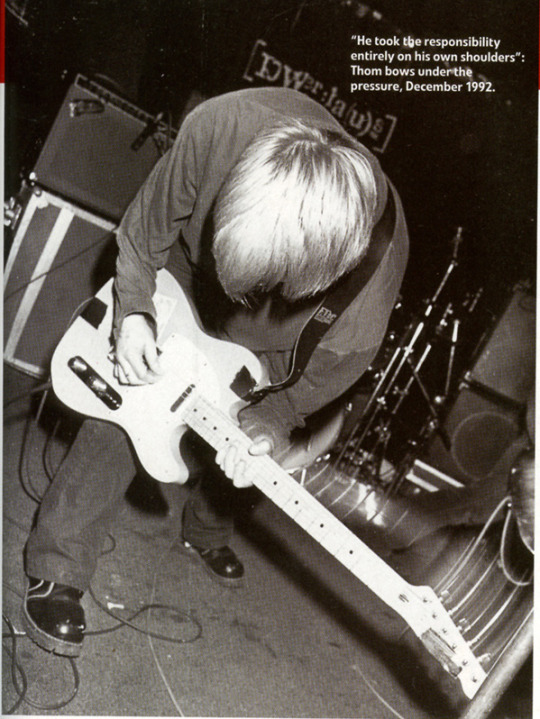
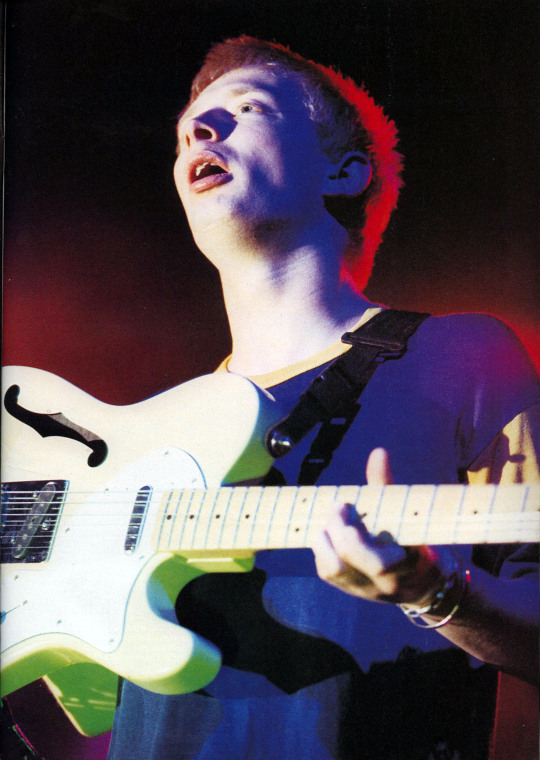
Left: a rare photo of Thom playing a cream Fender Telecaster Standard at a gig in December 1992 — presumably a touring backup for his black Tele Standard (Q #179). Right: Thom holding his Fenix-brand Tele Thinline copy during a gig in early-1995 (Rock&Folk).
This week, we updated Thom's page with more info on his Pablo Honey and The Bends era Telecasters. There's now better documentation of the mods done to his original black Tele Standard, his black Tele Thinline, and his Fenix Thinline copy. There's also info on Thom borrowing three different Teles from Jonny — see if you can guess which ones.
None of these guitars were used after touring for The Bends finished, either because of disinterest or because they were stolen. The theft of the latter two in October 1995 caused Thom to buy some vintage 70s Telecasters. He used those vintage instruments heavily from OK Computer through Hail To The Thief. Like the past two, his new "no1" Telecaster was also black, but this time it was a Deluxe with Wide Range humbuckers.
It was already mentioned on Thom's page, but I'd like to highlight a blog post from Deviation Street Magazine. They shared some awesome photos from Radiohead's gig at The Joiners Arms on February 18, 1993 — four days before the release of Pablo Honey! The writing offers a nice step back in time to an era when Radiohead was basically unknown.
And as on Jonny's page, we've started adding links to the table of contents to ease navigation.
17 notes
·
View notes
Text
Updates to Jonny's Guitars


First: Jonny rehearsing on his Gibson ES-125T at Radiohead's studio, most likely in April 2022 (thesmile). Second: Jonny playing his vintage Gibson Les Paul Custom at The Smile’s show at Place Bell in Montreal on July 15, 2023 (timsnowphoto).
We've finally updated Jonny's page with info on his latest guitars, including some that we haven't mentioned on the blog yet. First up is the ES-125T used live with The Smile for Colors Fly. Next is the Gibson Les Paul Custom, which he's often used to play Bending Hectic so he won't need to re-tune his natural Les Paul to the song's EADGG#D# tuning. It's likely the same LP Custom that he played for a Junun show in 2015. There's a few Fenders too: the natural Telecaster with a Strat headstock seen on stands behind him during The Smile rehearsals, a blue Mustang used for a couple of songs with Dudu Tassa in 2021, and the 1951 Fender Nocaster that Jonny borrowed from Tassa for Jarak Qaribak performances.
In addition, we've added a little bit of clarification about pickup wiring to the articles on his Tele Plus instruments. And we've noted the replacement "tone" knob recently added to his natural Les Paul.
Last, we've started to add links to the table of contents, so it's easier to navigate to the entry for the instrument you're looking for.
#Jonny Greenwood#Radiohead#The Smile#Gibson#Les Paul#ES-125T#Fender#Telecaster#Mustang#Jarak Qaribak#Dudu Tassa
22 notes
·
View notes
Text
Recent Artist Page Updates
We've added six of Thom's The Smile pedalboards to his page, so you no longer need to dig through the blog to find all that info.
Thom’s keyboards page has been brought up to date, and some extra info and clarity has been added to entries about older gear. Also, it’s finally alphabetized.
Ed’s amplifiers page has been updated with new info on the various Mesa Boogie amps he used in the 90s, plus many more photos. It has also been alphabetized. Big thanks to MSJ for the info on Mesa amps!
More photos have been added for the Marshall Shredmaster entry on Jonny's effects page, showing his settings over the years.
More photos have been added to Thom's amplifiers page for his 2000s Dave Peterson AC30 amps and his 1960s fawn Vox AC30 amp. These once again show Thom's affection for the Vox normal channel.
Thanks to “strangenewsfroma” for pointing out Ed’s Clapton Strat on 2017 performances of Lucky. We’ve added the guitar to Ed’s entry for his third Clapton Strat “ST3”, as it’s probably the same guitar with a new pickguard.

Thom recording with the Smile at Abbey Road studio 2 in early-2023. Lately, he's used his 1963 "upside down" AC30/6 quite often at live shows, but it seems he still likes his 1962 "fawn" AC30/6 best.
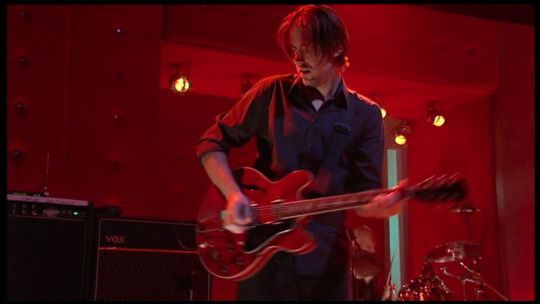
Ed’s black Mesa Boogie Trem-O-Verb and Dave Petersen AC30 can be seen in this photo from Radiohead’s Jonathan Ross performance of Fake Plastic Trees on May 30, 2003 (radiohead.com). A guitar radio receiver can be seen on top of the Trem-O-Verb.
7 notes
·
View notes
Note
Hello King of gear!!! i was watching the MTV beach house anyone can play guitar video, and i noticed johnny greenwood might have used a different pedal than a shred master or overdrive, i was just wandering if you would know which one he used? and what settings were on it.
That white enclosure on Jonny's board during the MTV Beach House performance is the Marshall Shredmaster clone that Plank built for Jonny in 1993. By the end of 1994, it was "flattened due to being stomped on", and Jonny went back to using a regular Shredmaster.

As for the settings, your guess is as good as anyone's, since half the knobs went missing pretty quick!
5 notes
·
View notes
